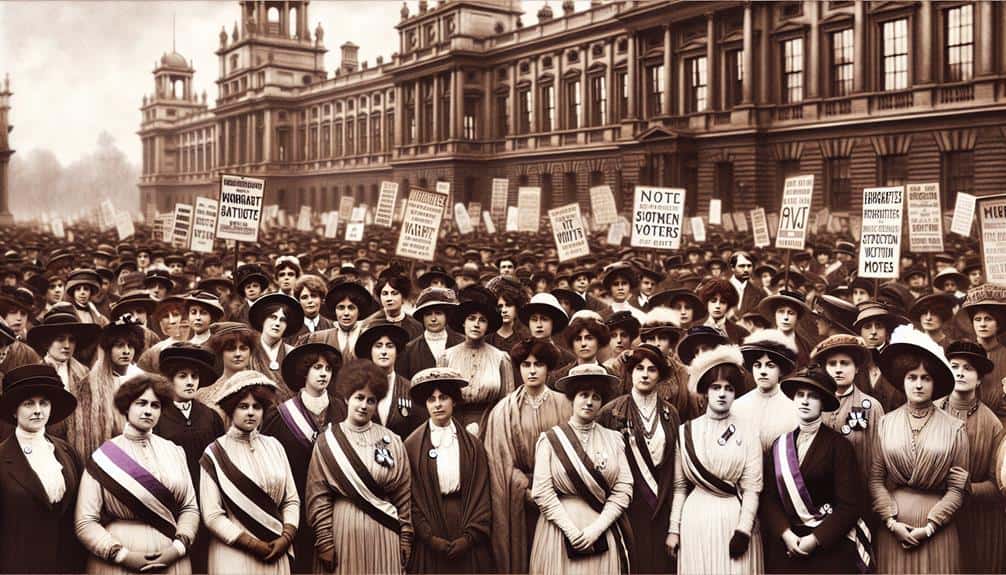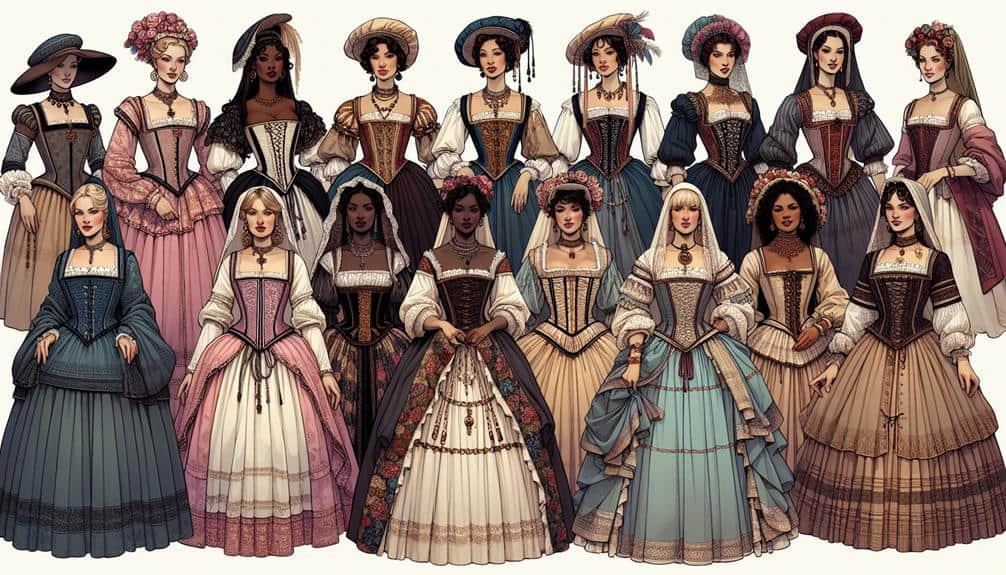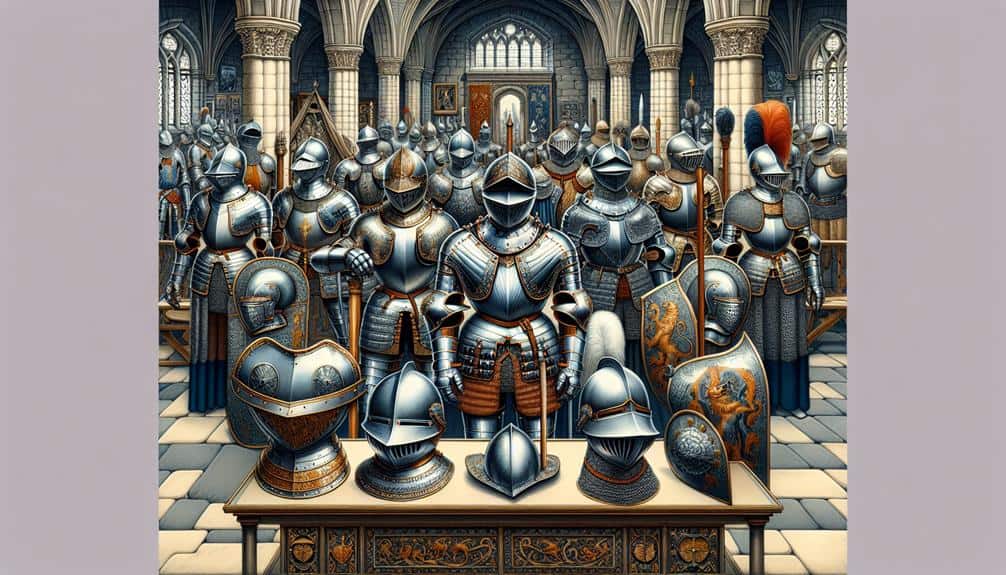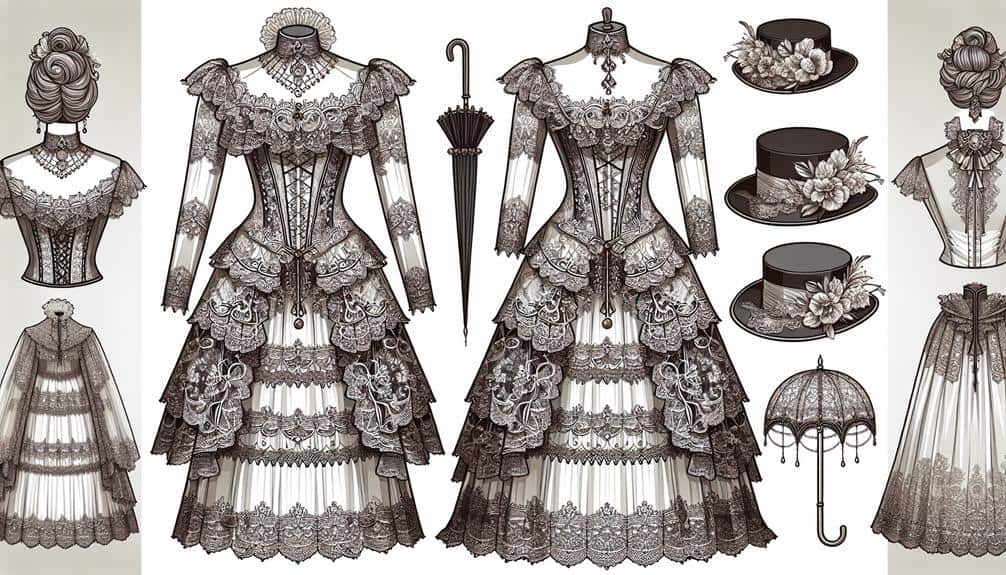Imagine stepping back in time to the Edwardian era, where suffragettes donned their protest attire like armor on a battlefield. But why did these brave women choose their outfits as tools for activism?
The layers of meaning behind their clothing choices reveal a strategic and symbolic approach that goes beyond mere fashion statements. As you explore the intricacies of suffragette protest attire, you will uncover a world where every button, every color, and every stitch carried a message of defiance and determination, shaping not only a movement but also a legacy that continues to resonate today.
Key Takeaways
- Suffragettes wore protest attire to symbolize dignity, purity, and hope for the cause.
- Practical clothing allowed for movement and endurance during long campaigns.
- Fashion statements increased visibility, challenged norms, and empowered women politically.
- Suffragette attire faced challenges from societal expectations, financial constraints, and lack of acceptance.
Suffragette Protest Attire Symbolism
The symbolism embedded in the Suffragette protest attire of the Edwardian Era served as a powerful visual tool to convey their message of women's rights and equality. Every piece of clothing worn by these brave women was meticulously chosen to make a symbolic statement. The colors purple, white, and green became synonymous with the movement. Purple symbolized dignity and loyalty, white represented purity and virtue, and green stood for hope and renewal. By incorporating these colors into their clothing, Suffragettes transformed their attire into a powerful medium for expressing their cause.
Additionally, the act of wearing tailored jackets and skirts challenged traditional gender norms, making a bold fashion statement. The deliberate choice to adopt more masculine elements in their clothing was a protest against the restrictive and outdated ideals of femininity prevalent at the time. This fashion statement not only showcased their determination to fight for equality but also served as a visual representation of their refusal to conform to societal expectations.
Practicality of Suffragette Clothing
Pioneering the way for modern protests, the practicality of Suffragette clothing in the Edwardian Era wasn't just a matter of fashion but a strategic consideration in their fight for equality. Functionality was key in their choice of attire. Suffragettes often opted for loose, comfortable garments that allowed for ease of movement during marches and demonstrations. Practical elements like sturdy boots enabled them to stand for long hours, while durable fabrics guaranteed longevity despite frequent wear.
Comfort played a vital role in their clothing selection. The long hours spent campaigning required outfits that didn't restrict movement or cause discomfort. Suffragettes favored practical pieces like tailored jackets and long skirts that provided both coverage and mobility. Additionally, the choice of colors and patterns in their clothing wasn't just a fashion statement but a deliberate strategy to garner attention and convey solidarity.
Impact of Suffragette Fashion Statements
Suffragette fashion statements during the Edwardian Era greatly influenced public perception and advocacy for women's rights. The garments worn by suffragettes weren't just pieces of fabric; they were powerful tools of communication that conveyed messages of political empowerment and feminist expression.
Here are three key ways in which suffragette fashion made an impact:
- Visibility and Awareness: Suffragette fashion, with its bold colors, sashes, and symbolic accessories, helped suffragists stand out in public spaces. This increased visibility drew attention to the suffrage movement, sparking conversations and raising awareness about the need for women's political rights.
- Unity and Solidarity: Wearing suffragette attire created a sense of unity among supporters. Uniform elements like the color white or specific accessories fostered solidarity among suffragettes, reinforcing their shared goals and commitment to the cause.
- Challenge to Traditional Gender Norms: By defying conventional women's fashion of the time, suffragettes challenged societal norms and expectations. Their clothing choices symbolized a rejection of restrictive gender roles and a demand for equality and agency.
Challenges Faced by Suffragette Dress Reform
Challenges arise in the domain of suffragette dress reform as the movement navigates obstacles to redefine societal perceptions of women's attire and advocate for gender equality through fashion.
Gender norms and social expectations during the Edwardian era constrained suffragettes in their quest to revolutionize women's clothing. The suffragette attire, often considered unconventional and radical, faced backlash from conservative factions who viewed it as a threat to traditional gender roles. Women endeavoring to align their fashion choices with their beliefs faced financial constraints and limited access to suitable garments.
The cost of reform-oriented clothing and the lack of mainstream acceptance posed significant challenges for suffragettes seeking to promote their cause through attire. Despite these hurdles, suffragettes persisted in their efforts to use fashion as a tool for challenging gender norms and reshaping social expectations surrounding women's clothing.
Legacy of Suffragette Fashion in Cosplay
Incorporating the legacy of suffragette fashion into cosplay allows enthusiasts to embody the spirit of historical activism through intricate costume designs and attention to detail. Suffragette cosplay enthusiasts often aim for historical accuracy in their attire, aiming to pay homage to the brave women who fought for equality. Here are three key elements that make suffragette cosplay both impactful and educational:
- Color Symbolism: Incorporating the symbolic purple, white, and green colors into cosplay not only adds historical accuracy but also conveys the message of loyalty, purity, and hope that the suffragette movement stood for.
- Suffragette Accessories: From sashes with empowering slogans to ornate brooches and badges, attention to detail in accessories can elevate a suffragette cosplay outfit, providing insight into the diverse range of items used by real-life activists.
- Period-Appropriate Silhouettes: Embracing the Edwardian era's fashion silhouettes, such as high-neck blouses, long skirts, and tailored jackets, can transport cosplayers back in time and help them embody the essence of suffragette fashion activism.
Frequently Asked Questions
How Did Suffragettes Fund the Purchase of Their Protest Attire?
To fund their protest attire, suffragettes relied on various sources, including donations from supporters, fundraising events, and the sales of suffrage-related merchandise. These funding sources helped guarantee accessibility and inclusivity within the movement.
Were There Any Specific Guidelines or Rules for Suffragette Protest Attire?
In the historical context of the Edwardian era, suffragettes used fashion trends to make political statements. Breaking traditional gender roles, they wore protest attire to challenge societal norms and advocate for women's rights, showcasing their determination and resilience.
Did Suffragettes Face Backlash or Criticism for Their Fashion Choices?
Facing criticism and backlash, suffragettes bravely defied societal norms with their protest attire. Their bold fashion choices challenged the status quo, sparking discussions on women's rights and shifting fashion trends toward empowerment and individuality.
How Did Suffragettes Ensure Their Protest Attire Was Accessible to Women From All Socioeconomic Backgrounds?
To guarantee inclusivity and affordability, suffragettes in the Edwardian Era strategically designed protest attire that balanced fashion and empowerment. By utilizing simple yet symbolic elements, they aimed to reach women from all socioeconomic backgrounds, fostering unity in their movement.
Were There Any Specific Colors or Fabrics That Were Commonly Used in Suffragette Protest Attire?
Colors like purple symbolized loyalty, white for purity, and green for hope in suffragette protest attire. Fabrics like linen and cotton were popular due to their accessibility. Protest accessories included sashes, rosettes, and banners for visibility.



